Microsoft ends support for Internet Explorer on June 16, 2022.
We recommend using one of the browsers listed below.
- Microsoft Edge(Latest version)
- Mozilla Firefox(Latest version)
- Google Chrome(Latest version)
- Apple Safari(Latest version)
Please contact your browser provider for download and installation instructions.
November 13, 2020
Nippon Telegraph and Telephone Corporation
NTT announces new R&D projects of Digital Twin Computing
- Four grand challenges towards a new future world creating harmonized relationship between the Earth, society, and people
Nippon Telegraph and Telephone Corporation (NTT; Head office: Chiyoda-ku, Tokyo; President & CEO: Jun Sawada) has established four research and development goals (grand challenges) for digital twin computing (DTC)*1 on the Innovative Optical & Wireless Network (IOWN) concept *2 to pioneer new future societies. Specifically, NTT aims to realize technologies to communicate the sensitivities of the mind and the emotions, alter ego technologies to coexist and grow with people (Another Me), technologies to explore forms of future societies, and technologies to induce inclusive equilibrium solutions for the earth and its social and economic systems.
1. NTT's Initiatives (Grand Challenges)
In a future society where human diversity, complex social structures, and other uncertain global events are increasing, we will engage in the following four grand challenges to create a society with harmonized relationship among the Earth, a society, and a human.
(1) Mind-to-Mind Communications
This is a new form of communication that transcends differences in language, culture and individual characteristics such as experiences and sensitivities to enable direct understanding of each other's perceptions and emotions.
(2) Another Me
Not your spouse, not your child, not your best friend, but a new and irreplaceable partner, realizing your alter ego as "Another Me" to live and grow with you and expand your opportunities in life tenfold.
(3) An Exploring Engine for the Future Society
These technologies will realize the explorer engine of the future society that will enable individuals to explore societies of the future and choose the actions and behaviors they want.
(4) Inducing Inclusive Equilibrium Solutions for the Earth and its Social and Economic Systems
We will present an inclusive equilibrium to harmonize the autonomy of the global environment with the autonomy of the social and economic systems that are part of the global environment, and multiple options for social system transformation to lead to the equilibrium.
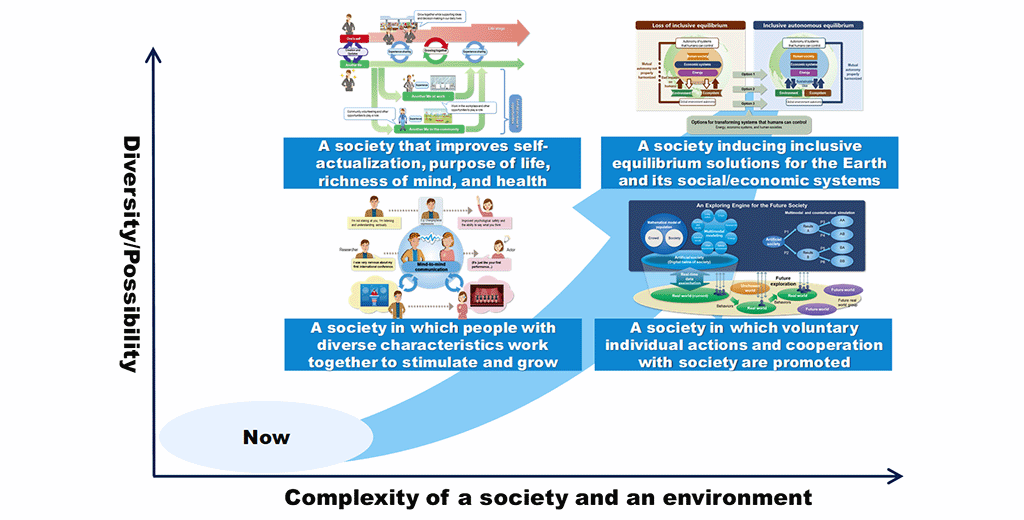 Figure.1 Societies envisaged by NTT
Figure.1 Societies envisaged by NTT
2. Overview of Each Initiative
(1) Mind-to-Mind communications
Overview
Mind-to-Mind communications will bring about a new stage of communications that will transcend differences in language, culture, experience, values and sensibilities to gain a real and direct understanding of how the other people perceive and feel things in their minds through the transmission of expressed words and expressions. This will reduce and eliminate communication discrepancies, increase psychological safety, and promote mutual understanding in our fragmented world to create an inclusive society where people with diverse characteristics can work together, stimulate each other and grow together.
Challenges
- By 2025, these technologies will transcend differences in communication characteristics such as superficial attitudes and expressions to achieve smooth, discrepancy-free face-to-face communications.
- By 2030, these technologies will achieve communications that will enable receivers to understand how senders perceive and feel things viscerally through messages transcending differences in experiences and sensibilities.
- After 2030, these technologies will bring about communications that enable receivers to directly understand how senders perceive and feel things in their minds and thus transcend differences in experiences and sensitivities.
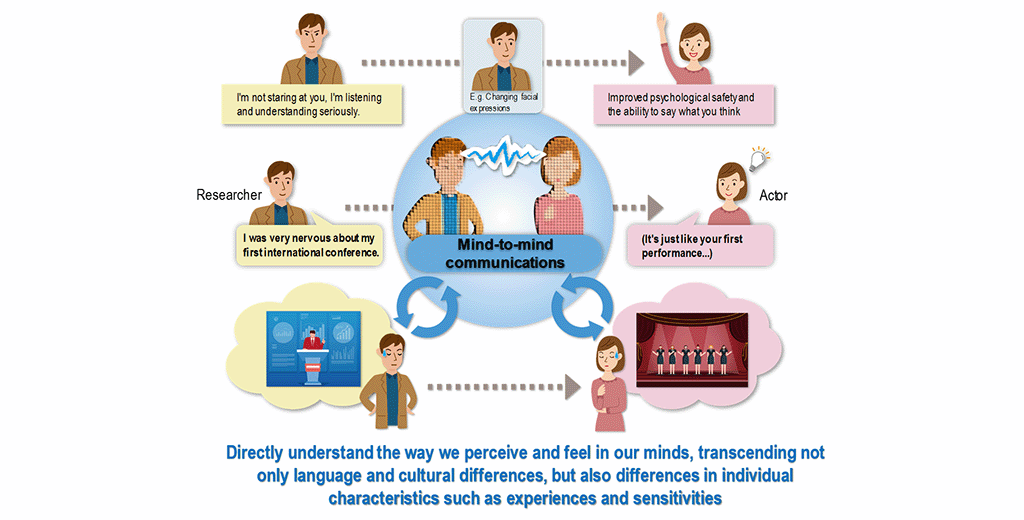 Figure.2 Mind-to-Mind Communications
Figure.2 Mind-to-Mind Communications
(2) Another Me
Overview
The loss of various opportunities in life has created social issues that include situations that make it difficult to balance work with childcare and nursing care, or the inability to participate in society even if one has the interest and drive to do so. By the year 2035, we will realize "Another Me", an alter ego that coexists and grows with itself to address these issues. "Another Me" aims to improve emotional well-being, health and life satisfaction by enabling users to perceive many opportunities in life such as balancing work and family and participating in many communities at the same time while enabling many growth opportunities in personal experience and growth with Another Me to accelerate self-realization. Currently, Professor Yasuo Deguchi and Program-Specific Associate Professor Takuro Onishi of Kyoto University are collaborating on research themes to clarify the elements that will enable Another Me to become active as a person's alter ego.
Challenges
- By the year 2027, technology will be achieved that enables humans to recreate their thoughts and memories in the virtual world to support thinking and decision-making.
- After 2030, technology will be achieved that will enable humans to cooperate and share in a variety of opportunities in real-world environments with their alter egos and then share those experiences with themselves.
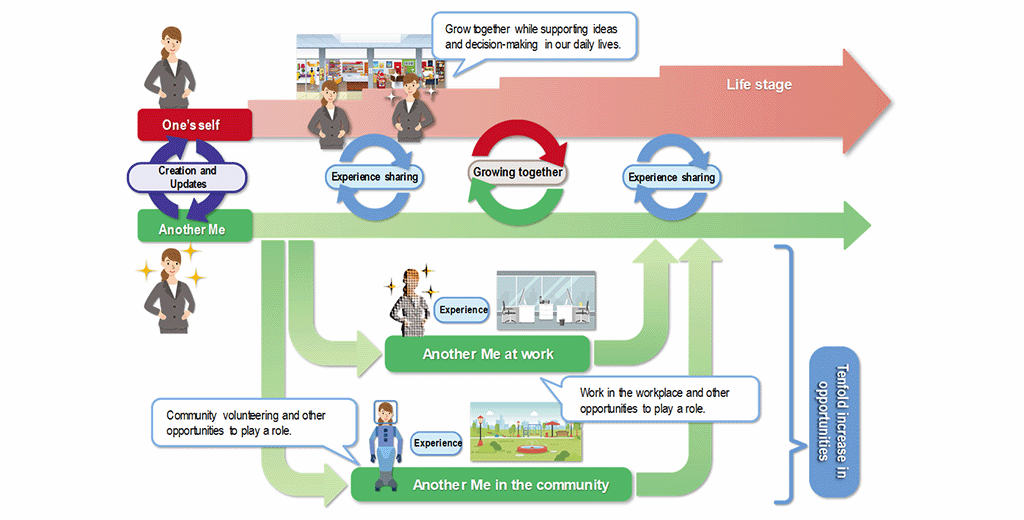 Figure.3 Another Me
Figure.3 Another Me
(3) An Exploring Engine for the Future Society
Overview
Increasingly complex social structures due to globalization and other factors, as well as increasing natural disasters and other uncertain events have made it difficult to see the impacts of individual actions or efforts on societies and natural environments, as well as the resulting feedback to the individual. Therefore, by using large-scale computation such as IOWN Photonic Disaggregated Computing *3, we are developing an "exploring engine for the future society" that will integrate various elements, such as individual behaviors, group activities, livelihoods, economic activities and the natural environment, to explore future societies that integrate these elements so that individuals can choose their desired actions and behaviors.
- E.g.1) Reduction in the number of infected people by refraining from going out, economic stagnation, reduction in CO2 emissions, increase in logistics.
- E.g.2) Increase in migration to suburbs with more people working from home, economic revitalization of local towns, reconstruction of central urban structures, changes in child-rearing environments.
- E.g.3) Reduction in CO2 emissions, reduction in gas stations and increase in electricity consumption through the use of electric vehicles
This will enable visualization of the impacts of individual actions and efforts on society and the natural environment, and also encourage many individuals to voluntarily act and cooperate to bring about the societies they want by seeking out the actions and cooperation to achieve the societies they want while thinking proactively.
Challenges
- By 2025, we will realize future exploration of naturally occurring group behaviors, such as urban behavior.
- By 2030, we will realize future exploration of urban lifestyles in the activities of groups with certain objectives.
- After 2030, we will realize future exploration of economic and other activities between groups with certain objectives.
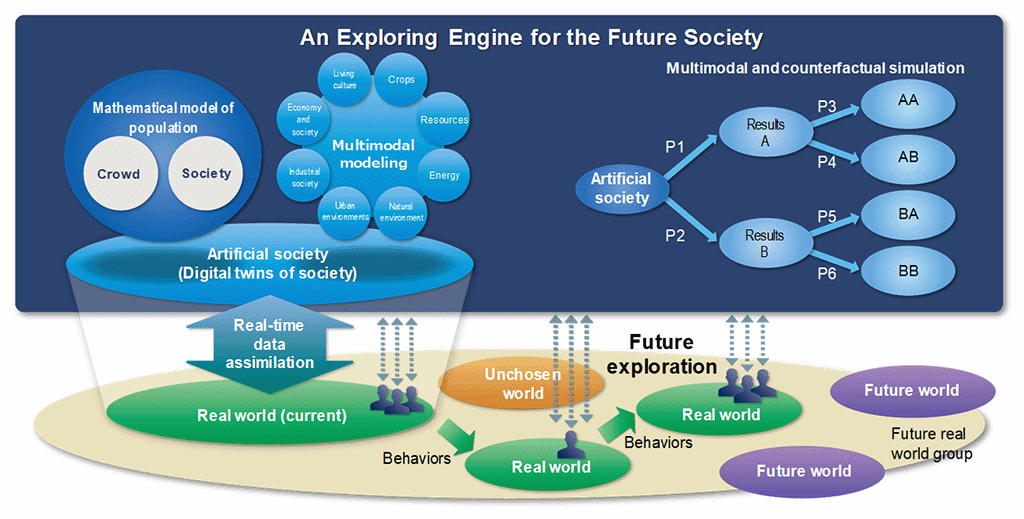 Figure.4 an Exploring Engine for the Future Society
Figure.4 an Exploring Engine for the Future Society
(4) Inducing Inclusive Equilibrium Solutions for the Earth and its Social and Economic Systems
Overview
The autonomy of the social and economic systems that are part of the global environment is not properly harmonized with the autonomy of the Earth's environment, and therefore is causing environmental changes that are harmful to humanity. For example, although the global water and weather cycles are self-sustaining, the activities of social and economic systems have resulted in extreme weather events, water shortages and environmental pollution. The relationship between the global environment and social and economic systems must maintain an inclusive equilibrium autonomously. To address these issues, we will present a new inclusive autonomous equilibrium and multiple options for social and economic system transformation to lead to it. This will enable us to understand and predict, for example, the chain reactions between the water and weather cycles and the use of water and primary energy in social and economic systems, and enable us to present multiple options to transform social and economic systems to a mechanism that uses these resources while maintaining an inclusive autonomous equilibrium to enable continued use while preventing increased water stress and environmental pollution.
Challenges
- By 2025, the chain reactions between energy production responding to changes in the water cycle, and economic systems and human societies will be grasped, and options on the transformation of energy, economic systems, and human societies to maintain an inclusive autonomous equilibrium will be presented.
- After 2030, the chain reactions between energy, economic systems, and human societies and the global environment and ecosystems will be grasped, and options on the transformation of energy, economic systems, and human societies to maintain an inclusive autonomous equilibrium of these relationships will be presented.
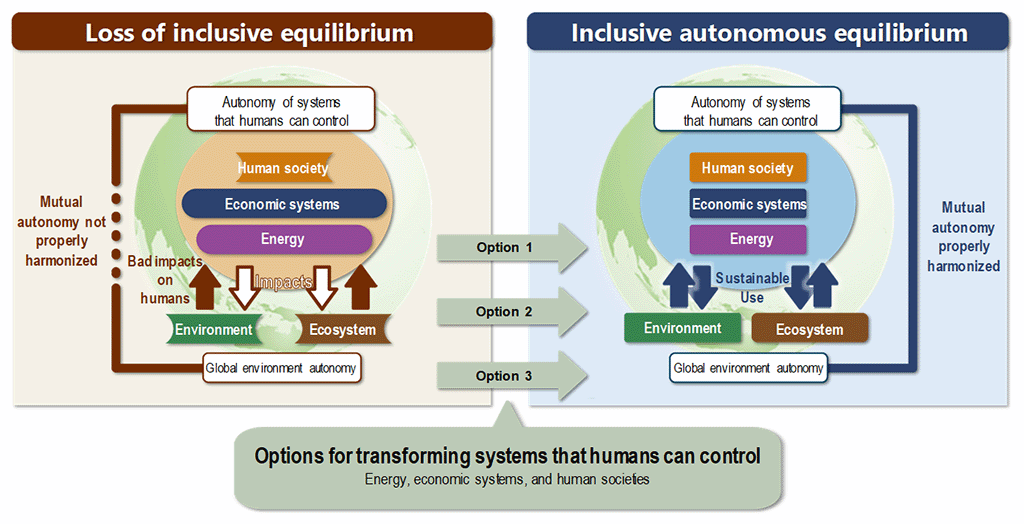 Figure.5 Inducing Inclusive Equilibrium Solutions for the Earth and its Social and Economic Systems
Figure.5 Inducing Inclusive Equilibrium Solutions for the Earth and its Social and Economic Systems
3. R&D Roadmap for Achieving the Grand Challenges
The research and development roadmap for achieving the four grand challenges is shown in Figure 6.
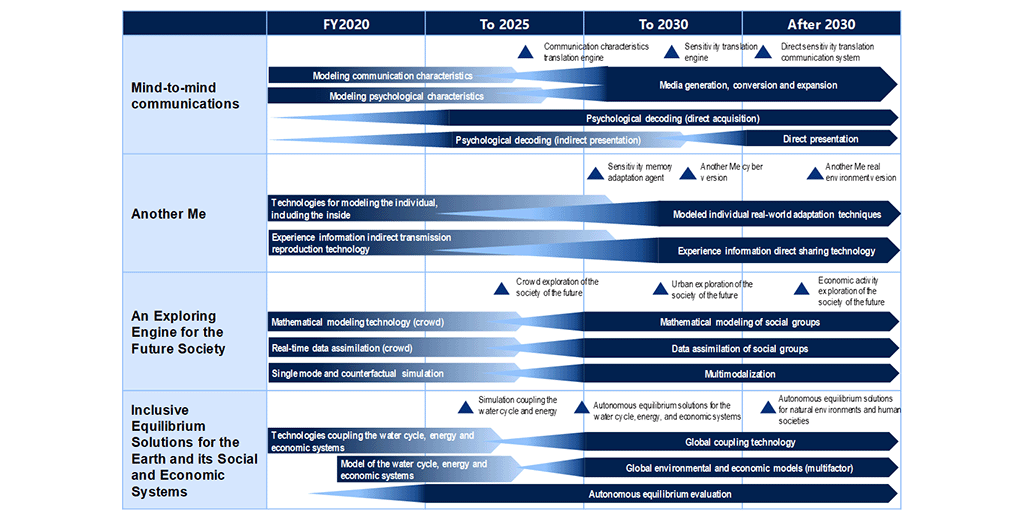 Figure.6 R&D Roadmap
Figure.6 R&D Roadmap
4. Initiatives for the future
We will pursue R&D in accordance with the research and development roadmap indicated above in Section 3 to realize the four grand challenges we have set. The realization and utilization of large-scale computational resources is essential to proceed with these grand challenges. Therefore, we will promote the development of technologies to realize the large-scale computing environments required to meet these four grand challenges. We are also planning to develop technologies to realize the grand challenges and implement them in society through collaboration with partner companies in the IOWN Global Forum.
An overview of our efforts will be presented at NTT R&D Forum 2020 Connect (attached), to be held between November 17-20, in a live webcast entitled "Beyond Digital Twins - Digital Twin Computing" (November 18, 2020, 3:00-4:00 p.m.).
References
*1https://www.rd.ntt/e/dtc/DTC_Whitepaper_en_2_0_0.pdf
*2https://www.rd.ntt/_assets/pdf/techreport/NTT_TRFSW_2020_EN_W.pdf
*3https://group.ntt/en/newsrelease/2020/04/16/200416a.html
* "Another Me" is a trademark of NTT Corporation.
Appendix: NTT R&D Forum 2020 Connect
From Tuesday, November 17 to Friday, November 20, 2020, the NTT R&D Forum 2020 Connect will be held for four days under the concept of "Into the IOWN - Change the Future". This year's forum will be held online in view of the recent situation regarding novel coronavirus infections. In this forum, we will introduce in an easy-to-understand manner, the latest research findings and initiatives, including key technologies to realize the IOWN (Innovative Optical and Wireless Network) initiative proposed in May 2019, use cases including the "Remote World" of the post-corona era as well as the vision of "Space Environment and Energy Laboratories" established for zero environmental impact.
Exhibition of elemental technologies related to the digital twin computing grand challenges
- Elemental technology related to "Mind-to-Mind Communications" to be exhibited:
M06 "Conversation support considering communication individuality" - Elemental technology related to "Another Me" to be exhibited:
A01 "Digital twin computing technologies" - Elemental technology related to "An Exploring Engine for the Future Society" to be exhibited:
A07 "Real-time aggregation of high-precise vehicle locations" - Elemental technology related to "Inclusive Equilibrium Solutions for the Earth and its Social and Economic Systems" to be exhibited:
E01 "Next-generation environmental energy technologies"
Contact
Nippon Telegraph and Telephone Corporation
Research and Development Planning Department
iown–pr@hco.ntt.co.jp
Information is current as of the date of issue of the individual press release.
Please be advised that information may be outdated after that point.
NTT STORY
WEB media that thinks about the future with NTT










